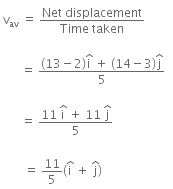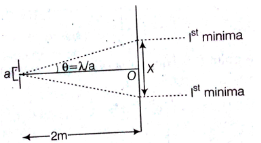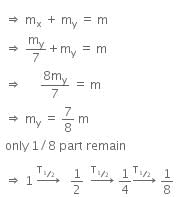Test: NEET 2014 Past Year Paper - NEET MCQ
30 Questions MCQ Test NEET Past Year Papers - Test: NEET 2014 Past Year Paper
Q. No. 1 - 45 carry 4 marks each and 1 mark is deducted for every wrong answer.
The mean free path of molecules of a gas,(radius ‘r’) is inversely proportional to :
A particle is moving such that its position coordinates (x, y) are (2m, 3m) at time t = 0,
(6m, 7m) at time t = 2s and (13m, 14m) at time t= 5s.
Average velocity vector  from t = 0 to t = 5s is :
from t = 0 to t = 5s is :
(6m, 7m) at time t = 2s and (13m, 14m) at time t= 5s.
Average velocity vector
Dependence of intensity of gravitational field (E) of earth with distance (r) from centre of earth is correctly represented by:
When the energy of the incident radiation is increased by 20%, the kinetic energy of the photoelectrons emitted from a metal surface increased from 0.5 eV to 0.8 eV. The work function of the metal is :
In an ammeter 0.2% of main current passes through the galvanometer. If resistance of galvanometer is G, the resistance of ammeter will be:
A balloon with mass ‘m’ is descending down with an acceleration ‘a’(where a<g). How
much mass should be removed from it so that it starts moving up with an acceleration ‘a’ ?
The Binding energy per nucleon of nuclei are 5.60 MeV and 7.06 MeV ,
respectively. In the nuclear reaction the value of energy Q released is :
The angle of a prism is ‘A’. One of its refracting surfaces is silvered. Light rays falling at an angle of incidence 2A on the first surface returns back through the same path after suffering reflection at the silvered surface. The refractive index μ, of the prism is :
The resistance in the two arms of the meter bridge are 5 and R
, respectively. When the
resistance R is shunted with an equal resistance, the new balance point is at The
resistance ‘R’ is :
Two cities are 150 km apart. Electric power is sent from one city to another city through copper wires. The fall of potential per km is 8 volt and the average resistance per km is 0.5 The power loss in the wire is :
A system consists of three masses m1, m2 and m3 connected by a string passing over a pulley P. The mass m1 hangs freely and m2 and m3 are on a rough horizontal table (the coefficient of friction = μ). The pulley is frictionless and of negligible mass. The downward acceleration of mass m1 is :
(Assume m1 = m2 = m3 = m)
If the kinetic energy of the particle is increased to 16 times its previous value, the percentage change in the de−Broglie wavelength of the particle is :
A beam of light of λ=600 nm from a distant source falls on a single slit 1mm wide and the resulting diffraction pattern is observed on a screen 2m away. The distance between first dark fringes on either side of the central bright fringe is :
A block hole is an object whose gravitational field is so strong that even light cannot escape
from it. To what approximate radius would earth (mass = 5.98 × 1024 kg) have to be
compressed to be a black hole ?
The oscillation of a body on a smooth horizontal surface is represented by the equation,
X = A cos (ωt)
Where X = displacement at time t
ω = frequency of oscillation
Which one of the following graphs shows correctly the variation ‘a’ with ‘t’ ?
A solid cylinder of mass 50 kg and radius 0.5 m is free to rotate about the horizontal axis. A massless string is wound round the cylinder with one end attached to it and other hanging freely. Tension in the string required to produce an angular acceleration of 2 revolutions s−2 is :
The ratio of the accelerations for a solid sphere (mass ‘m’ and radius ‘R’) rolling down an incline of angle ‘θ’ without slipping and slipping down the incline without rolling is :
A thin semicircular conducting ring (PQR) of radius ‘r’ is falling with its plane vertical in a horizontal magnetic field B, as shown in figure. The potential difference developed across the ring when its speed is v, is :
In the Young’s double−slit experiment, the intensity of light at a point on the screen where the path difference is λ is K,( λ being the wave length of light used). The intensity at a point where the path difference is λ/4, will be :
A radio isotope ‘X’ with a half life 1.4 × 109 years decays to ‘Y’ which is stable. A sample of the rock from a cave was found to contain ‘X’ and ‘Y’ in the ratio 1 : 7. The age of the rock is
Light with an energy flux of 25 x 104Wm−2 falls on a perfectly reflecting surface at normal incidence. If the surface area is 15 cm2, the average force exerted on the surface is
Certain quantity of water cools from 70°C to 60°C in the first 5 minutes and to 54° C in the next 5 minutes. The temperature of the surroundings is
A monoatomic gas at a pressure P, having a volume V expands isothermally to a volume
2v and then adiabatically to a volume 16v. The final pressure of the gas is: (Take γ = 5/3)
A projectile is fired from the surface of the earth with a velocity of 5ms−1 and angle θ with the horizontal. Another projectile fired from another planet with a velocity of 3 m/s at the same angle follows a trajectory which is identical with the trajectory of the projectile fired from the earth. The value of the acceleration due to gravity on the planet is (in ms−2 ) is : ( given g = 9.8 m/s2)
In a region, the potential is represented by V(x, y, z) = 6x − 8xy − 8y + 6yz, where V is in volts and x, y, z are in meters. The electric force experienced by a charge of 2 coulomb situated at point (1,1,1) is:
Hydrogen atom in ground state is excited by a monochromatic radiation of λ = 975 Å . Number of spectral lines in the resulting spectrum emitted will be:
The barrier potential of a p-n junction depends on:
(a) type of semi conductor material
(b) amount of doping
(c) temperature
Which one of the following is correct?
If n1, n2, and n3 are the fundamental frequencies of three segments into which a string is
divided, then the original fundamental frequency n of the string is given by:
If force (F), velocity (V) and time(T) are taken as fundamental units, then the dimensions of mass are:
If the focal length of objective lens is increased then magnifying power of :
|
94 docs|192 tests
|




























